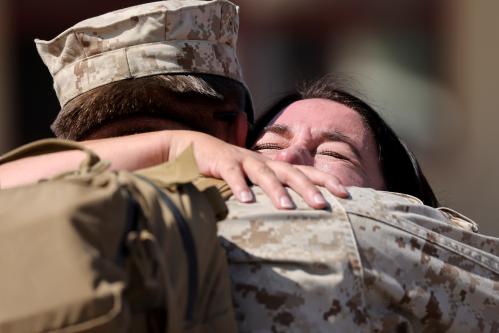The intelligence breach was bad enough, current and former fighter pilots said. But Defense Secretary Pete Hegseth’s refusal to acknowledge that he should not have disclosed sensitive information about when American fighter pilots would attack sites in Yemen, they said, was even worse.
On air bases, in aircraft carrier “ready rooms” and in communities near military bases this week, there was consternation. The news that senior officials in the Trump administration discussed plans on Signal, a commercial messaging app, for an impending attack angered and bewildered men and women who have taken to the air on behalf of the United States.
The mistaken inclusion of the editor in chief of The Atlantic in the chat and Mr. Hegseth’s insistence that he did nothing wrong by disclosing the secret plans upend decades of military doctrine about operational security, a dozen Air Force and Navy fighter pilots said.
Worse, they said, is that going forward, they can no longer be certain that the Pentagon is focused on their safety when they strap into cockpits.
“The whole point about aviation safety is that you have to have the humility to understand that you are imperfect, because everybody screws up. Everybody makes mistakes,” said Lt. John Gadzinski, a former Navy F-14 pilot who flew combat missions from aircraft carriers in the Persian Gulf. “But ultimately, if you can’t admit when you’re wrong, you’re going to kill somebody because your ego is too big.”
He and other pilots said that each day since Monday, when The Atlantic published an article about the chat disclosures, had brought a stunning new revelation. First came the news that Mr. Hegseth had put the operational sequencing, or flight schedules, for the F/A-18 Hornets targeting the Houthi militia in Yemen on March 15 in the unclassified Signal group chat, which included several other senior officials.
“We intentionally don’t share plans with people who don’t need to know,” said one Navy F/A-18 pilot, who has flown frequently in missions in the Middle East. “You don’t share what time we’re supposed to show up over a target. You don’t want to telegraph that we’re about to show up on someone’s doorstep; that’s putting your crew at risk.” He and several other current and former pilots spoke on the condition of anonymity to avoid reprisals from the Pentagon and from allies of President Trump.
But then came Mr. Hegseth’s initial response to the disclosures. He attacked Mr. Goldberg as a “so-called journalist,” and sought refuge in a semantic argument, saying that he had never disclosed “war plans.”
So on Wednesday, The Atlantic published the actual text of what he had written, at 11:44 a.m. the day of the attack, in the group chat: “1215et: F-18s LAUNCH (1st strike package),” Mr. Hegseth texted, some 30 minutes before it happened. “1345: ‘Trigger Based’ F-18 1st Strike window Starts (Target Terrorist is @his Known Location so SHOULD BE ON TIME).”

 www.nytimes.com
www.nytimes.com
On air bases, in aircraft carrier “ready rooms” and in communities near military bases this week, there was consternation. The news that senior officials in the Trump administration discussed plans on Signal, a commercial messaging app, for an impending attack angered and bewildered men and women who have taken to the air on behalf of the United States.
The mistaken inclusion of the editor in chief of The Atlantic in the chat and Mr. Hegseth’s insistence that he did nothing wrong by disclosing the secret plans upend decades of military doctrine about operational security, a dozen Air Force and Navy fighter pilots said.
Worse, they said, is that going forward, they can no longer be certain that the Pentagon is focused on their safety when they strap into cockpits.
“The whole point about aviation safety is that you have to have the humility to understand that you are imperfect, because everybody screws up. Everybody makes mistakes,” said Lt. John Gadzinski, a former Navy F-14 pilot who flew combat missions from aircraft carriers in the Persian Gulf. “But ultimately, if you can’t admit when you’re wrong, you’re going to kill somebody because your ego is too big.”
He and other pilots said that each day since Monday, when The Atlantic published an article about the chat disclosures, had brought a stunning new revelation. First came the news that Mr. Hegseth had put the operational sequencing, or flight schedules, for the F/A-18 Hornets targeting the Houthi militia in Yemen on March 15 in the unclassified Signal group chat, which included several other senior officials.
“We intentionally don’t share plans with people who don’t need to know,” said one Navy F/A-18 pilot, who has flown frequently in missions in the Middle East. “You don’t share what time we’re supposed to show up over a target. You don’t want to telegraph that we’re about to show up on someone’s doorstep; that’s putting your crew at risk.” He and several other current and former pilots spoke on the condition of anonymity to avoid reprisals from the Pentagon and from allies of President Trump.
But then came Mr. Hegseth’s initial response to the disclosures. He attacked Mr. Goldberg as a “so-called journalist,” and sought refuge in a semantic argument, saying that he had never disclosed “war plans.”
So on Wednesday, The Atlantic published the actual text of what he had written, at 11:44 a.m. the day of the attack, in the group chat: “1215et: F-18s LAUNCH (1st strike package),” Mr. Hegseth texted, some 30 minutes before it happened. “1345: ‘Trigger Based’ F-18 1st Strike window Starts (Target Terrorist is @his Known Location so SHOULD BE ON TIME).”

Signal Chat Leak Angers U.S. Military Pilots
Men and women who have taken to the air on behalf of the United States expressed bewilderment after the leak of attack plans. “You’re going to kill somebody,” one pilot said.



 We will forget her emails when you admit they were a HUGE security risk.
We will forget her emails when you admit they were a HUGE security risk.